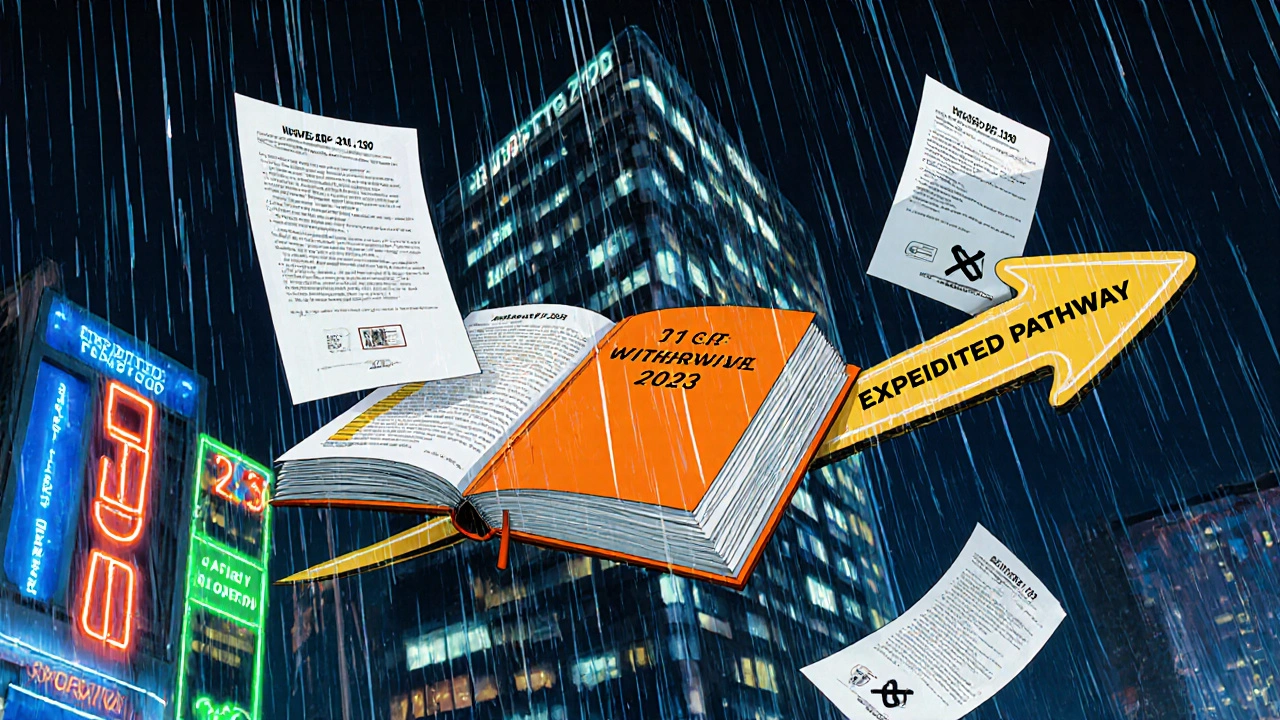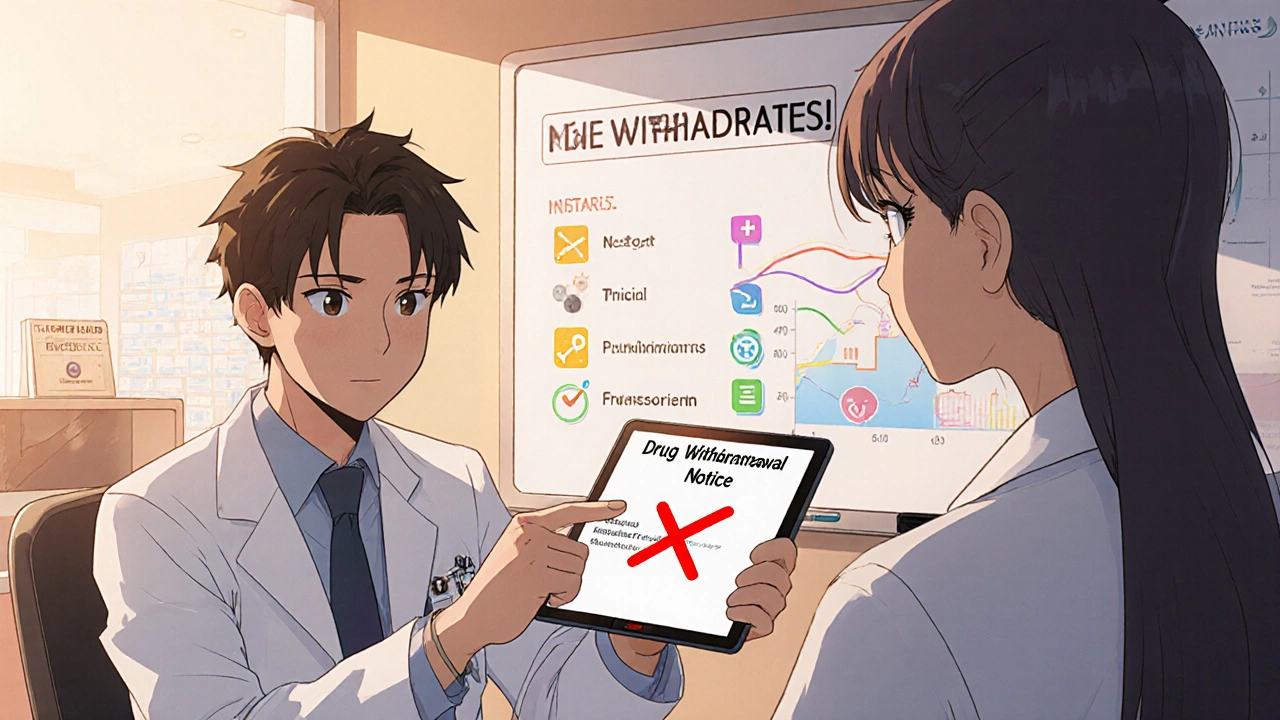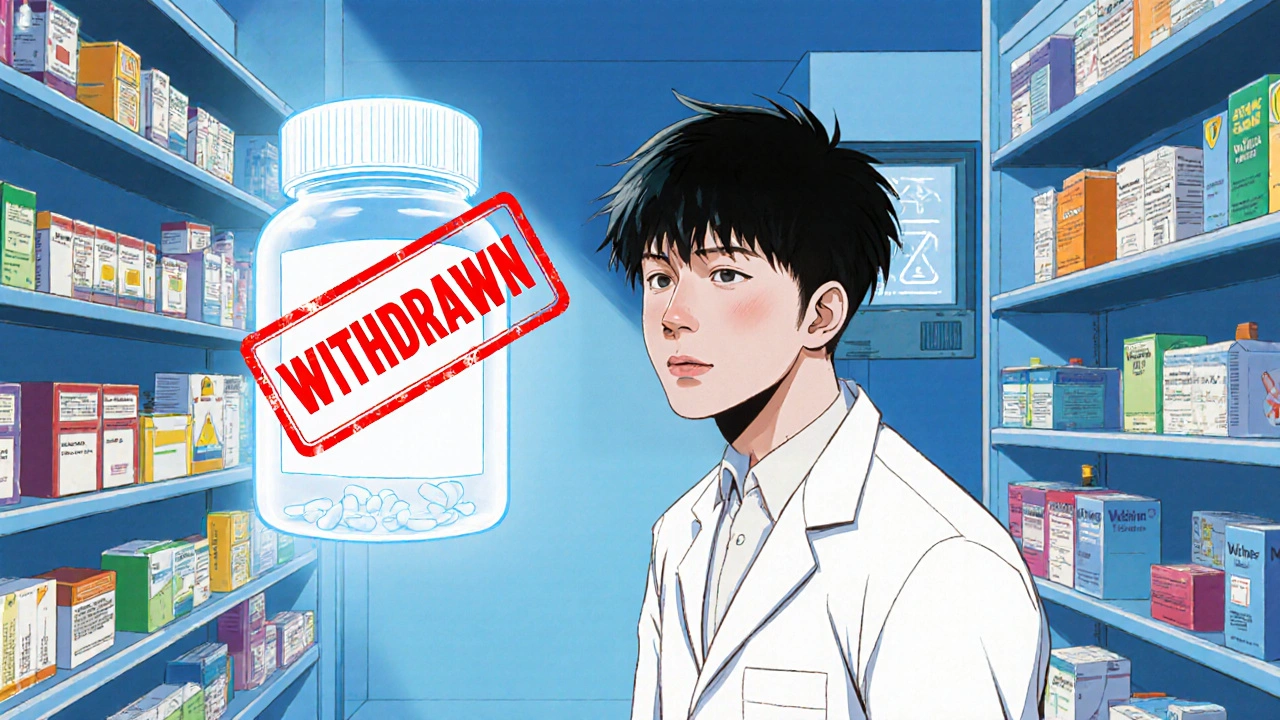FDA Drug Withdrawal Timeline Estimator
Withdrawal Timeline Calculator
Ever wondered why a pill you’ve been taking suddenly disappears from pharmacies? The answer usually lies in a drug withdrawal - a regulatory move that pulls a medication off the market because it no longer meets safety or effectiveness standards. While the headline sounds dramatic, the process behind it is a maze of laws, agency actions, and real‑world consequences for patients and doctors.
What Exactly Is a Drug Withdrawal?
In plain English, a drug withdrawal (sometimes called a recall) happens when a manufacturer stops selling a medication because new evidence shows the product is unsafe, ineffective, or violates regulatory rules. The U.S. Food and Drug Administration (FDA) defines a withdrawal as the point when the sponsor "has ceased its own distribution of the drug, whether or not it has ordered a recall of previously distributed lots" (FDA Guidance for Industry, 2018). This definition makes a clear line between a routine supply interruption and a true market exit triggered by risk.
Drug Withdrawal is a regulatory action that removes a medication from commercial availability due to safety, efficacy, or compliance concerns.
The U.S. Regulatory Framework
The FDA’s authority comes from the Federal Food, Drug, and Cosmetic Act (FD&C Act). Two sets of regulations govern withdrawals:
- 21 CFR 314.150 covers mandatory withdrawals for drugs with traditional approval.
- 21 CFR 314.161 addresses voluntary withdrawals initiated by manufacturers.
Both pathways require the FDA to publish a notice in the Federal Register, update the Orange Book, and give sponsors a chance to respond.
Key Reference: The Orange Book
The Orange Book is the FDA’s official list of approved drug products and their therapeutic equivalence evaluations. When a drug is withdrawn, the FDA marks it on the “FR Notice Determination of Safety or Effectiveness List.” This status tells generic manufacturers whether they can still cite the withdrawn product as a reference for their own approvals.
Orange Book is a catalog that tracks approved drugs, their therapeutic equivalence codes, and withdrawal status.
New Power: The Consolidated Appropriations Act 2023
Before 2023, the FDA could only pull a drug after a lengthy, often opaque process. The Consolidated Appropriations Act of 2023 gave the agency a fast‑track route for certain cases. Under Section 3210, the FDA can expedite withdrawal when one of four conditions is met:
- The sponsor fails to conduct required post‑approval studies.
- A confirmatory study does not verify the expected benefit.
- External evidence shows the drug is unsafe or ineffective.
- The sponsor spreads false or misleading promotional material.
This new pathway adds a structured timeline: 30 days to respond to the agency’s notice, up to 60 days for a meeting, and a final decision within 180 days.
Consolidated Appropriations Act of 2023 is a legislation that grants the FDA expedited authority to withdraw drugs meeting specific safety or efficacy failures.

Voluntary vs. Mandatory Withdrawals: A Quick Comparison
| Aspect | Voluntary (21 CFR 314.161) | Mandatory (21 CFR 314.150) |
|---|---|---|
| Initiator | Drug sponsor | FDA |
| Typical trigger | Safety signal, commercial decision, post‑marketing study failure | Clear evidence of serious risk or ineffectiveness, court order |
| Public notice | Manufacturer‑issued press release; FDA may publish supplementary notice | Federal Register notice; updates to Orange Book |
| Timeline | Varies; often weeks to months | No fixed deadline; pre‑2023 average 46 months for accelerated‑approval drugs |
| Impact on generics | Reference product may remain if safety issue is batch‑specific | Reference product removed; generics must seek new reference |
How Withdrawals Affect Patients and Providers
When a drug disappears, the ripple effect is immediate. A 2023 Penn LDI study showed that, on average, patients continued receiving an ineffective oncology drug for 46 months after the confirmatory trial failed. In small‑cell lung cancer, the exposure rate hit 41 % of eligible patients. The delay isn’t just a statistic-it means people undergo unnecessary side‑effects, wasted money, and lost time that could have been spent on a more effective therapy.
Doctors must scramble to find alternatives. The American Society of Clinical Oncology reports an average of 72 hours for oncology clinics to devise a new treatment plan after a withdrawal notice. Pharmacists also face a steep learning curve; a 2022 survey found 63 % still had trouble interpreting Orange Book withdrawal symbols.
Oncology is a medical specialty focused on cancer diagnosis, treatment, and research.
International Lens: EMA and Health Canada
Outside the U.S., the European Medicines Agency (EMA) and Health Canada use “conditional” or “restricted” approvals that automatically trigger a review if post‑marketing data fall short. This built‑in safety net contrasts with the historic U.S. approach, where the FDA relied mainly on post‑marketing required studies (PMRs) for accelerated approvals. The EMA can withdraw a drug within weeks of a failed confirmatory study, whereas the U.S. pre‑2023 average hovered around four years.
European Medicines Agency (EMA) is a EU agency responsible for the scientific evaluation, supervision and safety monitoring of medicines.
Health Canada is a federal department that oversees the safety and efficacy of health products in Canada.

Case Study: The Makena Saga
Makena, a product approved in 2011 based on a surrogate endpoint, illustrates the worst‑case timeline. The FDA approved it in 207 days, but the confirmatory trial failed in 2020. The agency didn’t pull the drug until 2022 - a 1,500‑day gap. During that period, roughly 150,000 patients were exposed to a treatment that provided no measurable benefit.
Makena is a progestin medication approved for preventing preterm birth, later withdrawn after confirmatory study failure.
How Stakeholders Can Prepare for a Withdrawal
Being proactive helps minimize disruption. Here’s a practical checklist for clinicians, pharmacists, and patients:
- Subscribe to FDA’s Drug Safety Communications and monitor the Orange Book monthly.
- Maintain a list of alternative therapies for high‑risk drug classes (e.g., oncology, rare diseases).
- Develop a patient‑notification script that explains the reason, timeline, and next steps.
- Verify insurance coverage for substitute drugs before the recall takes effect.
- Document the switch in the electronic health record, noting the withdrawal notice reference number.
Future Outlook: Real‑World Evidence and Faster Decisions
The FDA is piloting a real‑world evidence (RWE) program with Flatiron Health data to monitor post‑approval outcomes in near real time. Early results suggest that integrating electronic health record data could shave months off the detection of ineffective therapies.
Flatiron Health is a company that provides oncology-specific real‑world data platforms for research and regulatory use.
Analysts predict a 25 % rise in withdrawal actions between 2023‑2027, affecting roughly $8 billion in annual sales. While industry groups worry about over‑aggressive pulls dampening innovation, most experts agree the net benefit-protecting patients from harmful or useless drugs-outweighs the risk.
What’s the difference between a recall and a withdrawal?
A recall usually targets specific lots that are defective or contaminated, while a withdrawal removes the entire product from the market because the drug itself no longer meets safety or efficacy standards.
How long does the FDA normally take to withdraw a drug?
Before the 2023 reforms, the average was about 46 months for accelerated‑approval drugs. The new expedited pathway aims to cut that to under 12 months.
Can a withdrawn drug still be used in other countries?
Yes. Each regulator decides independently. For example, a drug withdrawn by the FDA may remain on the market in the EU if the EMA finds the benefit‑risk balance acceptable.
What should patients do if their medication is withdrawn?
Contact the prescribing doctor right away. Ask for an alternative, confirm insurance coverage, and keep an eye on any official FDA notices that may arrive by mail or email.
Do pharmacies get notified before a withdrawal?
Yes. The FDA’s Federal Register notice is public, and most major pharmacy chains have automated feeds that flag withdrawn products in their inventory systems.


13 Responses
Reading the FDA's latest withdrawal framework feels like stepping into a labyrinth of legalese; each clause is a minotaur guarding a fragile promise of safety, and yet we are expected to trust the very system that erected those walls. The notion of a drug withdrawal is, on the surface, a simple corrective measure-but beneath lies a cascade of regulatory choreography that rivals any epic tragedy. One must ask: does the speed of action reflect a genuine commitment to patient welfare, or is it merely a bureaucratic reflex to public outcry? The Orange Book, that venerable ledger of approved therapeutics, now bears the scars of hurried edits, each entry a silent testament to a product's fall from grace. Consider the Consolidated Appropriations Act of 2023: its expedited pathway, while laudable, introduces a new set of pressures that could inadvertently incentivize premature market exits.
Moreover, the dichotomy between voluntary and mandatory withdrawals is more than a procedural footnote; it is a reflection of corporate calculus versus regulatory imperative. When sponsors elect to pull a drug voluntarily, they may mask deeper strategic motives-perhaps a commercial pivot or an attempt to preempt a harsher summons. Mandatory withdrawals, by contrast, can be perceived as the regulator's wrenching hand, a reminder that no entity is above the safety covenant. The statistical lag-46 months on average for accelerated approvals-was not merely an administrative oversight but a symptom of systemic inertia, a tissue of delay that patients felt in the form of prolonged exposure to ineffective treatments.
Internationally, the EMA's swifter response mechanisms underscore the United States' need for reform; weeks versus years, a stark juxtaposition that challenges our confidence in domestic oversight. Yet, the promise of real‑world evidence initiatives, such as those spearheaded by Flatiron Health, offers a glimmer of hope that future withdrawals may be predicated on near‑real‑time data rather than retrospective analysis. Ultimately, the ethical calculus rests on balancing innovation with vigilance-an equilibrium as delicate as the pharmacokinetics of the very drugs we seek to protect. In this evolving landscape, every stakeholder must confront the uncomfortable truth that complacency is the antidote to progress.
The analysis in the post is spot‑on, especially regarding the lag in mandatory withdrawals. However, the data could have been bolstered with more recent case studies; the Makena example, while illustrative, dates back a few years. The new 2023 expedited pathway is a step forward, yet the author underplays potential industry pushback. A balanced view would acknowledge that faster withdrawals might strain manufacturers' ability to conduct thorough post‑marketing studies. Overall, the piece provides a solid foundation for understanding FDA mechanisms.
I think the article does good job explainin the process, but it could use more cultural perspective. In India we see similar issues but with even less transparency-patients often only learn about a withdrawal after the drug is gone from shelves! The author mentions EMA, yet the FDA's global influence means its delays impact worldwide health. Also, the term "real‑world evidence" sounds fancy, but the reality is data quality still needs work. Anyway, good effort, just wish it covered more global examples.
Wow, this is a deep dive! 😮 I love how the post breaks down the Orange Book stuff-never knew that existed. 📚 If you’re a pharmacist, this is gold. 🎉 Keep those detailed breakdowns coming, they really help us understand the nitty‑gritty.
i love how the post lays out the diff between recall and withdrawal, very clear. the tables are super helpful, even if they look a bit dense. good job!
The post drips with pretentious jargon while offering little practical guidance. It's as if the author enjoys watching readers drown in regulatory minutiae. The so‑called "checklist" is barely a checklist-more a wall of text that no clinician has time to read. Meanwhile, the real‑world impact on patients gets buried under legalese. If the FDA truly cares, they'd simplify the process, not complicate it with endless forms and timelines. Unfortunately, we've been handed a bureaucratic maze that feels designed to protect corporations more than patients.
Hey everyone! 🌟 This post is packed with info, and I think it’s a great resource for both clinicians and patients. 😊 If you’re ever unsure about a withdrawal, remember to check the FDA’s safety communications and keep an up‑to‑date list of alternatives. Stay informed, stay safe! 💪
Thank you for breaking down such a complex topic! I appreciate the clear explanations and the practical checklist at the end. It’s reassuring to know there are steps we can take to prepare for a sudden drug withdrawal. Your friendly tone makes the information feel more accessible.
You’ve hit the nail on the head with the pharma‑centric attitude! The FDA’s new fast‑track pathway is just a buzzword to appease angry patients while keeping the industry’s profit margins intact. This whole “real‑world evidence” spiel is loaded with jargon that masks the fact that data pipelines are still years away from being reliable. It’s a classic case of regulatory rubber‑stamp masquerading as consumer protection. 🙄🚀
The timeline is finally catching up with reality.
Honestly, I suspect there’s a hidden agenda behind every “expedited” decision. The industry wants to keep control, and any appearance of speed is just a smokescreen. Think about it: if the FDA truly acted in patients’ best interests, we’d see transparent data, not vague promises. The simple truth is that big pharma pulls strings in the shadows, and we’re left watching the show. It’s all a grand performance to keep us complacent. Stay vigilant.
Great point about staying vigilant! I think it’s important for us to ask questions, even if they seem simple. The post gives a solid foundation, but we all need to keep digging for more clarity. Let’s keep the conversation going and help each other navigate these complex updates.
Ah, the classic "let’s all be earnest about vigilance" routine – how refreshingly naïve. One might suggest that the very concept of vigilance has been commercialized, packaged, and sold back to us by the same entities we’re urged to scrutinize. Nevertheless, if you must indulge in this performative concern, ensure your emoticons are properly placed – 😊 – lest you appear incompetent. In any case, let us all continue to pat ourselves on the back for our moral superiority. 🙃